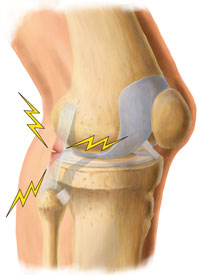Lateral Collateral Ligament (LCL) Sprain and Injury
The lateral collateral ligament (LCL) is the ligament located in the knee joint. Ligaments are thick, strong bands of tissue that connect bone to bone. The LCL runs along the outside of the knee joint, from the outside of the bottom of the thighbone (femur) to the top of the lower-leg bone (fibula). The LCL Reconstruction Surgery helps keep the knee joint stable, especially the outer aspect of the joint.
An injury to the LCL could include straining, spraining, and partially or completely tearing any part of that ligament. According to Orthogate, the LCL is one of the more commonly injured ligaments in the knee. Because of the location of the LCL, it’s common to injure the LCL along with other ligaments in the knee.
Causes
The main cause of LCL injuries is direct-force trauma to the inside of the knee. This puts pressure on the outside of the knee and causes the LCL to stretch or tear.
Symptoms
Symptoms of an LCL injury can be mild or severe, depending on the severity of the sprain or if it’s torn. If the ligament is mildly sprained, you may not have any symptoms at all. For a partial tear or complete tear of the ligament, your symptoms may include:

Sports Medicine
How is an LCL injury diagnosed?
To diagnose an LCL injury, your doctor will examine your knee and look for swelling. They’ll also move your knee in various directions to determine where your pain is and how severe your symptoms are.
If your doctor believes you may have a torn ligament, you may undergo imaging tests like X-rays or MRI scans. These tests will allow your doctor to see the soft tissues inside the knee.
Treatments
The treatment options for LCL injuries will depend on the severity of the injury and your lifestyle.
For minor injuries, treatment may include:
For more severe injuries, treatment may also include physical therapy, rehabilitation, or surgery. Physical therapy strengthens and helps you regain range of motion. Surgery may include ligament repair or reconstruction.
Surgery doesn’t usually treat injuries to only the LCL. However, the LCL is often injured along with other ligaments in the knee. In these cases, surgery is probably necessary.
Prevention
It’s difficult to prevent knee ligament injuries because they’re often a result of an accident or unforeseen circumstance. However, several preventive measures can help minimize the risk of a knee ligament injury, including:
About Doctor:
Dr.KHALEELULLAH is a renowned gold medal award-winning Orthopaedician in Hyderabad. He has got extensive experience of more than 15 years and positioned himself as the best orthopedic surgeon in Telangana and Andhra Pradesh. He worked for nearly 8 years in the prestigious Nizams Institute of Medical Sciences(NIMS), Hyderabad where he acquired vast skills and knowledge about managing complicated orthopedic problems. He proved himself as the right Ortho Surgeon with MCH specialization with his deep interest in the area of joint reconstruction surgeries.